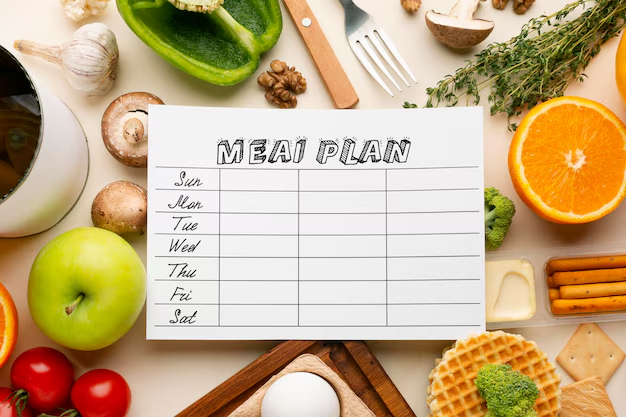Last updated on May 28th, 2025 at 05:34 pm
Discover the ultimate weight loss meal plan! A 7-day guide with recipes, tips, and calorie counts to help you achieve your weight loss goals effectively.
Table of Contents
Toggle7 Powerful Weight Loss Meal Plan Tips to Shed Pounds Quickly
Struggling to lose weight can be daunting, but with the right weight loss meal plan, you can shed those extra pounds effectively and healthily. The secret lies in understanding how to fuel your body while creating a calorie deficit. This guide provides actionable tips, delicious recipes, and practical strategies to help you achieve your weight loss goals.
Why a Weight Loss Meal Plan is Important
A weight loss meal plan offers structure, ensuring you consume the right nutrients while avoiding empty calories. When designed correctly, it eliminates guesswork, reduces cravings, & helps you stay consistent.
1. Understand Your Caloric Needs
The first step in any effective weight loss meal plan is to calculate your daily caloric needs. Use an online calorie calculator to determine your Basal Metabolic Rate (BMR) and adjust it based on your activity level. Aim for a moderate calorie deficit of 500–750 calories daily for sustainable weight loss.
- Tip: Incorporate nutrient-dense foods like vegetables, lean proteins, and whole grains to meet your caloric target.
2. Prioritize Protein in Your Meals
Protein is a vital component of any weight loss meal plan. It boosts metabolism, promotes satiety, and helps preserve muscle mass during calorie restriction.
- Examples:
- Breakfast: Greek yogurt with fresh berries and nuts.
- Lunch: Grilled chicken salad with avocado and olive oil dressing.
- Dinner: Baked salmon with steamed broccoli and quinoa.
Including a portion of protein in every meal keeps hunger pangs at bay and supports muscle recovery post-workout.
3. Balance Your Macronutrients
A balanced weight loss meal plan includes the right proportions of macronutrients:
- Proteins: For muscle repair and satiety.
- Carbohydrates: For energy. Opt for complex carbs like oats, sweet potatoes, and brown rice.
- Fats: For hormone regulation and brain function. Use sources like olive oil, nuts, and seeds.
4. Include High-Fiber Foods
Fiber-rich foods play a crucial role in a weight loss meal plan. They keep you feeling full, regulate digestion, and stabilize blood sugar levels.
- Best Sources of Fiber:
- Fruits: Apples, pears, and berries.
- Vegetables: Broccoli, spinach, and carrots.
- Whole grains: Oats, barley, and quinoa.
- Legumes: Lentils, chickpeas, and black beans.
5. Stay Hydrated
Hydration is often overlooked in weight loss, but it’s essential. Drinking water before meals can reduce calorie intake, and staying hydrated helps in metabolizing fat.
- Tip: Replace sugary beverages with infused water, herbal teas, or black coffee.
6. Plan and Prep Your Meals
Meal prepping is a game-changer for anyone following a weight loss meal plan. It saves time, ensures portion control, and minimizes the temptation to order takeout.
- Steps for Meal Prepping:
- Choose recipes that align with your goals.
- Prepare meals for 3–4 days in advance.
- Use portion-sized containers to store meals.
7. Monitor and Adjust Your Plan
No weight loss meal plan is one-size-fits-all. Track your progress and make adjustments as needed. Use a food journal or apps like MyFitnessPal to log your meals and stay accountable.
Sample Weight Loss Meal Plan
Day 1:
- Breakfast: Oatmeal with almond milk, sliced banana, and chia seeds.
- Snack: A handful of almonds and an apple.
- Lunch: Grilled chicken with mixed greens, cucumber, and a light vinaigrette.
- Snack: Low-fat Greek yogurt with honey.
- Dinner: Stir-fried tofu with brown rice and steamed vegetables.
Day 2:
- Breakfast: Scrambled eggs with spinach and whole-grain toast.
- Snack: A protein bar (low sugar).
- Lunch: Quinoa salad with chickpeas, cherry tomatoes, and lemon dressing.
- Snack: Baby carrots with hummus.
- Dinner: Baked cod with roasted sweet potatoes and asparagus.
Mistakes to Avoid in a Weight Loss Meal Plan
- Skipping Meals: Leads to overeating later.
- Underestimating Calories: Measure portions accurately.
- Relying on Processed Foods: Opt for fresh, whole foods instead.
- Neglecting Exercise: Combine your meal plan with regular physical activity.
FAQs on Weight Loss Meal Plan
1. What is a weight loss meal plan?
A weight loss meal plan is a structured diet plan designed to help individuals reduce calorie intake while maintaining a balanced, nutrient-rich diet.
2. How can I create a weight loss meal plan?
Start by calculating your caloric needs, balancing macronutrients, and including nutrient-dense foods. Meal prepping can make sticking to the plan easier.
3. What foods should I avoid in a weight loss meal plan?
Avoid sugary beverages, fried foods, and processed snacks. Focus on whole, natural foods for better results in your weight loss meal plan.
4. How important is portion control in a weight loss meal plan?
Portion control is crucial. Overeating healthy foods can still lead to calorie surplus, hindering your weight loss progress.
5. Can I follow a weight loss meal plan without exercise?
While exercise enhances weight loss, a calorie-deficit weight loss meal plan can still help you shed pounds. However, exercise improves overall health.
6. What are some high-protein foods for weight loss?
Chicken breast, eggs, Greek yogurt, tofu, lentils, and salmon are excellent high-protein options for your weight loss meal plan.
7. Is intermittent fasting compatible with a meal plan?
Yes, intermittent fasting can complement a weight loss meal plan by creating a calorie deficit and promoting better control over meal timing.
8. How do I stay motivated on a meal plan?
Set realistic goals, track progress, and celebrate small victories. Having a support system or accountability partner can also help.
9. Can cheat days fit into a meal plan?
Occasional cheat days can help reduce cravings, but moderation is key. Plan them wisely to avoid derailing your progress.
10. How long does it take to see results from a meal plan?
Results vary, but with consistency, you may notice changes in 4–6 weeks. A sustainable weight loss of 1–2 pounds per week is a healthy goal.
Conclusion
A well-designed weight loss meal plan is your roadmap to achieving your fitness goals. By incorporating these tips and maintaining consistency, you’ll not only shed pounds but also develop healthier eating habits for life. Stay patient, monitor your progress, and make adjustments as needed.
Start your journey today with these strategies, and watch your efforts transform into visible results!
Explore More on Health & Wellness!
Check out these must-read blogs:
✅ 10 Healthy Meal Prep Ideas for Busy Professionals – Save time and eat healthier with these easy meal prep ideas!
✅ 30-Day Home Workout Plan PDF: Get Fit at Home – Stay active with this structured workout plan from the comfort of your home.
✅ How to Improve Your Gut Health Naturally – Discover science-backed ways to boost digestion and overall wellness.
✅ Health for Life: 7 Proven Ways to Stay Fit & Happy – Simple yet powerful strategies to maintain a healthy and joyful life.
✅ The Power of Meditation: How Daily Practice Transforms Your Mind & Body – Unlock inner peace and mental clarity through meditation.
✅ Yoga for Beginners: A Complete Guide to Starting Your Practice – Strengthen your body and calm your mind with this beginner-friendly yoga guide.
For more expert health tips, explore our Health & Fitness category and take a step toward a healthier, happier lifestyle today! 🚀💪






